This page has been set up for all things
supernatural in Derbyshire and Derby. As Richard Felix says, Derby is the
haunted capital of Britain. There are more ghosts in Derby than anywhere else.
Also, with Derbyshire have a massive convergence of lay-lines as well as a deep
history – there are Danelaw borders here, Bonnie Prince Charlie held his last
stand here and good old Joseph Wright the artist lived here to name but a few
points. I think that supernatural Derbyshire deserves a page by itself at
least.
Kinder Scout Mermaid's Pools, Derbyshire
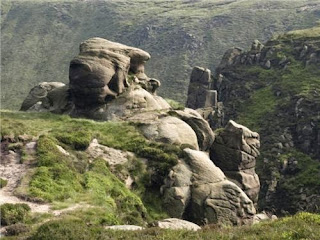 |
| Kinder Scout, Derbyshire |
 |
| Mermaids Pool, Kinder Scout, Derbyshire |
Part way up Kinder Scout, a mountain not far from Old Oak Woods, three miles from Hayfield in Derbyshire is The Mermaid’s Pool. It is thought that a beautiful nymph comes here to bathe. It is also thought that if someone visits the pool at the very beginning of Easter Sunday – midnight – they will meet this nymph and they will be granted good fortune, wealth and immortality. There is a cost of course. This person will love only the nymph and none other for the rest of their life.
In 1893, Robert Charles Hope related that the locals had heard gossip of this happening only once during the century previous. A man made the journey to The Mermaid’s Pool and came across the nymph. He was conducted to the cavern and the tradition says that the nymph was ‘pleased with this humble mortal and he lingered there some time’. It is said the he was gifted with immortality.
Tradition says that to meet the nymph, you must stare intently into the deep waters that legend has it is connected to the Atlantic Ocean. No fish can survive in the supposedly salty waters, a possible clue as to the verity of the legend of its connection to the Atlantic at least.
What is known is that marine biologists sent down submersible cameras to locate the base of the pool, but the end of the lengthy cables were reached before the bottom was found.
Whatever the route of the legend, it is definitely a mysterious place. It inspired Mrs Humphrey Ward to use it in her novel and Henry Kirke White (1785-1806) wrote a ballad about the desolate place (see below) in which, for poetic licence, the nymph was transformed into a siren, a being that tempts people to their deaths rather than gifting them with riches and immortality.
In a version of the Mermaid’s Pool legend, this is what happens. Any who shun her hospitality and the rewards she offers, she will drag down them down to a watery grave. It is said that several people have drowned here, could it really be the nymph playing out her revenge for her shunned heart?
There is only one documented example of a person actually going up to The Mermaid’s Pool at the start of Easter Sunday and taking the nymph’s reward.
Tradition says that to meet the nymph, you must stare intently into the deep waters that legend has it is connected to the Atlantic Ocean. No fish can survive in the supposedly salty waters, a possible clue as to the verity of the legend of its connection to the Atlantic at least.
What is known is that marine biologists sent down submersible cameras to locate the base of the pool, but the end of the lengthy cables were reached before the bottom was found.
Whatever the route of the legend, it is definitely a mysterious place. It inspired Mrs Humphrey Ward to use it in her novel and Henry Kirke White (1785-1806) wrote a ballad about the desolate place (see below) in which, for poetic licence, the nymph was transformed into a siren, a being that tempts people to their deaths rather than gifting them with riches and immortality.
In a version of the Mermaid’s Pool legend, this is what happens. Any who shun her hospitality and the rewards she offers, she will drag down them down to a watery grave. It is said that several people have drowned here, could it really be the nymph playing out her revenge for her shunned heart?
There is only one documented example of a person actually going up to The Mermaid’s Pool at the start of Easter Sunday and taking the nymph’s reward.
His name was Aaron Ashton, a retired soldier from Hayfield. As the story goes, he went up to the pool’s edge on many an Easter Sunday, but never saw the nymph and so, never received his extended life. What is curious though, is that he lived to the age of 104; a phenomenal age for 1835, considering that the average life expectancy at the time was 45. Perhaps the nymph’s unseen hand really did have a part to play.
 |
| Kinder Scout, Derbyshire |
Now, here’s Henry Kirke White’s ballad:
There is a land within a northern clime
Where many a mountain reaches to the clouds,
That rests their billowy fleeces on its he
That rests their billowy fleeces on its he
And roll adown its rugged, storm-rent side
At the foot of such a mountain in this land
There lies a pool, dark and mysterious,
Shadowed by blackened rocks, and sedges drear,
In which no reedy warbler builds its nest;
No heather nods its bells unmusical
Around its banks, no somber-coated bee
Hums over it a busy melody;
No speckled trout or dark-backed umber there
Wake the still waters with the circling leaps;
No chattering grouse drops in the doubtful wave
Feathers that float like tiny argosies;
Nor furry-footed coney stops to drink
Its waters salt as those their watch that keep
Over the doomed towns of Palestine.
With solemn awe the lonely shepherd treads
Passed the weird margin of the mountain tarn,
Fearing the sprite that dwells within its depths,
And rot, and ague, and a thousand ills
He thinks such fearsome folk are wont to give
To those that trespass on their sovereignty.
But one there was a sprightly lad and tall,
And gifted with a face in which for master;
Action and thought seemed always combating,
Who always felt attracted to the pool,
And sat for many hours plumbing its depth
With anxious eyes; but nought saw he therein
Save the reflection of his comely face.
Warning he had full oft from wiser men
To meddle not in such a dangerous quest,
Now seek for death where death was surely found:
For ‘tis believed that on a certain eve
When summer fruits are ripe, and in the sky
The stars can scarcely light their shining lamps,
And the soft air is strangely musical
With the faint soft hum of fairy merriment,
A maiden, strangely fair, but strangely formed,
Rises from out of the pool, and by her songs
And heavenly beauty lure to shameful death
The luckless wight who hears her melodies.
But youth is curious, and the shepherd lad
Longed with intense desire to see the maid.
He dreamt of her by night, her white arms seemed
To lock him in a clinging, fond embrace;
She haunted him by day as moodily
He watched beside the pool, and seemed to see
In each reflected cloud her drapery.
At last the night arrived, the sun just dipped
His rosy fingers in the pathless sea,
Leaving the world not dark, but hardly light;
The waning stars scarce marked the azure sky,
And zephyrs gentle cooled the heated earth:
‘Twas just the hour when night and morning meet,
When, watching still, the boy sat eagerly,
On a huge stone that darkened all the pool;
When suddenly that wave gleamed fitfully
With the sudden light, as in the tropic seas
The lambent waves shine with phosphoric glare,
And brighter grew the water, and the air
Was filled with music ravishingly sweet.
With open mouth and eager starting eyes
The youth stood gazing at these mysteries,
And saw from out the troubles waves arise
A maiden, clothed alone in loveliness;
Her golden hair fell o’er her shoulders white,
And curled in amorous ringlets round her breasts;
Her eyes were melting into love, her lips
Had made the very roses envious;
Withal a voice so full, and yet so clear,
So tender, made for loving dialogues.
And, then, she sang – sang of undying love
That waited them within her coral groves
Beneath the deep blue sea, and all the bliss
That mortals made immortal could enjoy,
Who lived with her in sweet community.
She sang, and stretching out her rounded arms,
She bade him leap and take her for his own –
With one wild cry he leapt, and with a splash
That roused the timid moorhen from her nest,
Sank ‘neath the darkling wave for evermore.
As a conclusion, it is not uncommon for pools connected with subterranean passages to either the sea or other pools to have legends concerning mermaids – there is of course, the myths concerning Lock Ness. There is Rostherne Mere which is connected to both the Atlantic and the Mersey. Rostherne Mere also has a link with Easter Sunday in common with the Kinder Scout Mermaid’s Pool.
At Rostherne, the mermaid can be heard singing and a person viewing it will be cursed with an unluckiness that can sometimes be proved fatal.
The connection between the mermaid granting immortality and Easter Sundays is also curious. It is thought to be a conscious effort by Christians to appropriate a local legend in an attempt to help spread Christianity.
I would also like to mention that Derbyshire has another mermaid’s pool. This one is on the top of a 500 metre tale, 1 mile long ridge called the Roaches, roughly half way between Buxton and Leek. But I will be covering this on another occasion. It is a fascinating place, equally as desolate as the Kinder Scout locale.
The Hound of the Baskervilles was always a fun story. I’ve always thought so. So I find it pleasant to hear about other oversized, phantom hounds that malevolently stalk the countryside. Whether it’s a guardian spirit for a church – similar to a Brittany Ankou – or the story of the Black Shuck that starred in the Darkness song of the same name.
Eckington Ghost Girl
Wolf Hunt of Wormhill
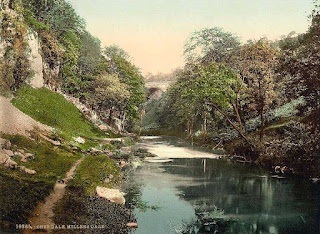 |
| Miller's Dale, Derbyshire |
The Hound of the Baskervilles was always a fun story. I’ve always thought so. So I find it pleasant to hear about other oversized, phantom hounds that malevolently stalk the countryside. Whether it’s a guardian spirit for a church – similar to a Brittany Ankou – or the story of the Black Shuck that starred in the Darkness song of the same name.
The last wolf in England was killed in the 16th century, so why are there still sightings of these strange beasts? One has been seen rampaging around the Derbyshire countryside between Buxton and Miller’s Dale. Locals and motorists alike have allegedly been chased by a large, shaggy phantom hound by night and leaping with immense speed after their cars.
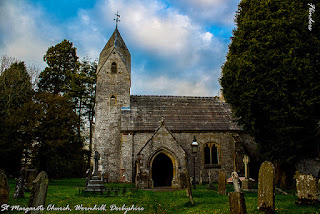 |
| St Margaret's, Wormhole, Derbyshire |
Around this area of Derbyshire is Wormhill. Up until the 17th century, this village was surrounded by ancient oaks that were crowded together. This was prime territory for wild animals to hunt. For curiosity’s sake, here is the piece about Derbyshire in the 1610 Britannia by William Camden the historian and antiquarian:
…there is no more danger now from wolves which in times past were hurtfull and noisome to this country; and for the chasing away and taking of which some there that held lands here at Wormhill, who thereupon were surnamed Wolvehunt, as appeareth plainely in the Records of the Kingdome…
The Bradwell Boggart
He’s a little piece of my researches that I hope you find interesting. It’s a piece taken from a book called Bradwell: Ancient and Modern that was published in 1912 – Bradwell is a village in Derbyshire. A man called Seth Evans wrote about a beast called a Lumb Boggart.
 |
| Bradwell, Derbyshire |
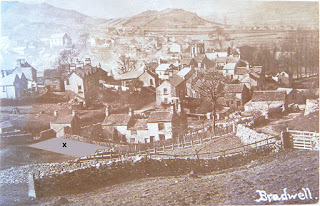 |
| Old Bradwell, Derbyshire |
In the book, Evans entitles this piece ‘an absurd tale which everybody believed even down to half a century ago. A Lumb, you might like to know is the old English word for pool and a Boggart is traditionally a type of rogue hobgoblin that had left their homes because their human co-inhabitants didn’t care for them properly, but by the 1800s, a boggart referred to something different. Where previously a boggart had been a shunned, rogue domestic goblin living in the wilds, living off what it could steal from travellers, it became interchangeable with the word ghost. Many tales from the late 1700s and most of the 1800s including boggarts have a lot of similarities with what we know categorise as cases of poltergeist activity.
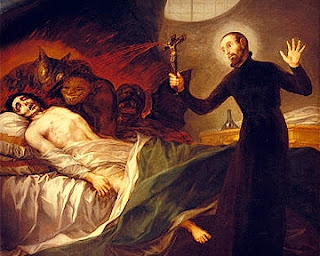 |
| Exorcism |
I did a little research into what an ousel was. Just for peace of mind and ease of reading, it’s a bird that nests in rocky crevices.
 |
| Ousel |
Anyway, here’s the extract:
It used to be said that about a century and a half ago (1710 ish) the body of a young girl who was supposed to have been murdered was found buried under the staircase of a house at Hill Head. The ghost of the girl appeared every night until everyone in the neighbourhood were terrified and thrown into a cold sweat. Unable to bear it any longer the people got a well-known individual who belonged to the Baptists… to undertake the task of ‘laying’ the ghost. As this individual professed to be able to rule the planets. Of course, no one doubted his power of getting rid of the ghost.
The time came, and the haunted house was filled with affrighted spectators when the exorcist appeared among them with his paraphernalia, and when he prayed until streams of sweat poured from his face as he knelt within a ring he had chalked on the chamber floor, the lookers-on kneeling around, and later afterwards declared that they “felt the floor move for yards up and down in quick succession.” Then the magician arose and exclaimed, “Arise! Arise! I charge and command thee,” when the spirit appeared, and the man ordered it to depart and assume the body of a fish, and to locate itself in the Lumb Mouth. He also ordered that every Christmas Eve the ghost should assume the form of a white ousel, and fly to Lumbly Pool.
Consequently, the family that lived at Hill Head moved soon after this incident.
Shady Lane funeral of the dead
 |
| Ashford in the Water, Derbyshire |
 |
| Great Langston, Derbyshire |
I have recently found out about a procession of twelve headless men that carry an empty coffin down Shady Lane at dusk. The lane itself runs from Great Longstone to Ashford-in-the-Water in Derbyshire. It is thought that empty coffins in a ghostly funeral procession were an omen of death. The coffin is implied by the spirits to be for the person that witnesses the terrifying event.
 |
| Renishaw Hall, Derbyshire |
I found this curious, especially as an empty coffin had been found in Renishaw Hall in 1895 between the ground floor and first floor during a stage of remodelling. This coffin had been nailed shut and when curious builders, servants and owners had opened it, they only found the imprint of a body within. Could these strange incidents be related?
Eckington Ghost Girl
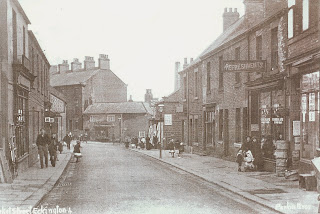 |
| Eckington, Derbyshire |
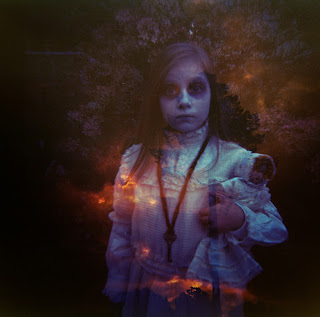 |
| Ghost girl of Eckington, Derbyshire |
Here’s a Derbyshire fairy tale from SO Addy’s, the collector of local stories. This is a story is said to have originated in the Derbyshire town of Eckington and in true fairy tale tradition it’s thought that this story was a morality tale told to young children.
It tells of a young girl with a golden cup. One day, her mother told her that she was going out and that the girl could while away the time playing with the cup. The girl asked a servant to get the cup for her from a cupboard, but the maid was too busy. The girl kept asking the servant over and over again whether she could have her cup.
But what happened next? The servant, infuriated with the girl’s constant nagging, murdered her and buried the girl’s body under one of the flagstones in the cellar. The mother returned later that day and asked the servant where her daughter was. The servant claimed that she’d not seen the daughter in hours. The mother looked for a while but couldn’t find her.
Now, I’ll let SO Addy finish off the tale in his own words:
Then the mother was deeply grieved, and she sat up all that night and all the next. On the third night as she sat alone and wide awake she heard the voice of her daughter outside the door saying, “Can I have my golden cup?” the mother opened the door, and when her daughter had repeated the question three times she saw her spirit, but the spirit vanished at once, and she never saw it more.
Sermon of the Dead, Chapel en la Frith
Here’s a curious piece I found about Dunscar Farm in Derbyshire. This is an extract from a book called Household Tales by SO Addy in 1895.
 |
| Hayfield, Derbyshire |
Here is another report from SO Addy. This is taken from his book, Household Tales, published in 1895. In Hayfield, Derbyshire during the 16th century, all the dead about the old village chapel rose in unison. Despite the date, it is more likely that this was a mass grave for flood victims that are recorded as being buried in 1754 in a letter written by Reverend Dr James Clegg, the minister of nearby Chapel-en-le-Frith. Here’s what the good reverend had to say:
… on the last day in august, several hundreds of bodies rose out of the grave in the open day… to the great astonishment and terror of several spectators. They deserted the coffin, and rising out of the grave, immediately ascended directly to heaven, singing in content all along as they mounted thro’ the air; they had no winding sheets, about them, yet did not appear quite naked, their vesture seem’d streak’d with gold, interlaced with sable, skirted with white, yet thought to be exceedingly light by the agility of their motions, and the swiftness of their ascent. They left a most fragrant and delicious odour behind them, but were quickly out of sight…
This might be an exaggeration or even an outright fictionalisation by a member of the clergy to enforce the idea of the resurrection in a sermon. If it is true, an exaggeration or an old fiction that’s gone down into local legend, then what can I say, it’s still fun
I would like to finish this article with a bit of vampire folklore. Similar occurrences have happened throughout Europe – and other areas of the world – throughout recorded history. People have been curious about the whys and wherefores of the dead reappearing above ground. All I can say for certain is that after death, it’s common for a body to bloat up with its own gases. Thus, drowned and forgotten bodies rise to the surface of their watery grave and in mass graves where numerous corpses swell, it’s possible for the surface of the ground to rupture and the dead underneath to break forth.
Cursed Bones of Dunscar Farm
Here’s a curious piece I found about Dunscar Farm in Derbyshire. This is an extract from a book called Household Tales by SO Addy in 1895.
There is an old farmhouse in the Peak Forest, in Derbyshire, at which, it is said, there once lived two sisters who loved the same man. To put an end to their rivalry one sister murdered the other, but the dying sister said that her bones would never rest in any grave. And so it happens that her bones are kept in a ‘chees-vat’ in the farmhouse which stands in the staircase window. If the bones are removed from the vat trouble comes upon the house, strange noises are heard at night, the cattle die, or are seized with illness.
Whatever the truth of the matter is, whether the bones were a curio or part of a practise to ward off evil spirits, the skull specifically has been mentioned in Clarence Daniels’s Ghosts of Derbyshire. There are also tales circulating of a very similar story at Tunstead Farm near Chapel-en-la-Frith in Derbyshire.




No comments:
Post a Comment